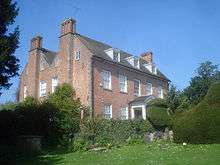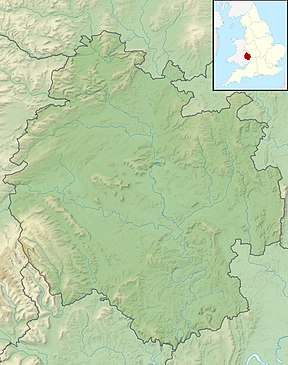Eye Manor
Eye Manor, Eye, Herefordshire, England is a Carolean manor house dating from the late 17th century. It was built for Ferdinando Gorges, descendant of the founder of the Province of Maine, and a trader in slaves and sugar. Noted for its interior plasterwork, the house is a Grade I listed building.
| Eye Manor | |
|---|---|
 "An astonishing surprise" | |
| Type | House |
| Location | Eye, Herefordshire |
| Coordinates | 52.2704°N 2.7399°W |
| Built | c.1673-1680 |
| Architectural style(s) | Carolean |
| Governing body | Privately owned |
Listed Building – Grade I | |
| Official name: Eye Manor | |
| Designated | 11 June 1959 |
| Reference no. | 1349522 |
 Location of Eye Manor in Herefordshire | |
History
Ferdinando Gorges (c.1565-1647) was an English soldier whose establishment of the Province of Maine saw him called the "Father of English Colonization in North America".[1] His descendant, also Ferdinando, bought the Eye estate in 1673 and began building the house shortly thereafter.[2] A datestone above the main doorway carries a date of 1680.[3] Coats of arms within the house carry the insignia of Gorges and of his wife, Meliora Gorges, née Hilliard.[4] Gorges' son, Henry sat as a member of parliament for Herefordshire in the early 18th century.[5]
In the 20th century Eye Manor was the home of the publisher Christopher Sandford,[6] who owned the Golden Cockerel Press, and his wife Lettice Sandford. Their son Jeremy Sandford, the writer and director of the television drama Cathy Come Home, grew up at the house.[7] Following his death in 2003, the manor was sold.[8]
In 2009 the house was bought by the Conservative politician Robert Jenrick for £1.1 million.[9][10] In April 2020, during the coronavirus pandemic, Jenrick, then serving as the Secretary of State for Housing, Communities and Local Government, became the subject of media interest when he visited the house, and his parents' home in Shrewsbury, in apparent contravention of the government's advice against non-essential travel.[11][12][13]
Architecture and description
Eye Manor is noted for the quality of its interior decoration,[14] which Pevsner describes as "an astonishing surprise".[3] The house is built of red brick to a traditional double-pile plan. Later additions include the doric porch which dates from the 18th century,[3] and some minor modification undertaken in the early 20th century. It is of two storeys, with cellars and attics.[4]
The plain exterior conceals the spectacular interior[15] which has "gorgeously enriched" panelling, bolection moulded stone fireplaces and "outstanding" plaster ceilings.[3] The quality and style of the plasterwork in the house bears similarities to that at Holyrood Palace which led Geoffrey Beard, a historian of English decorative arts, to suggest that the same craftsmen may have been involved.[lower-alpha 1][17]
Eye Manor is a Grade I listed building.[4]
Notes
- Sir John Summerson also notes the similarities between the woodwork and plasterwork at Holyrood and "early Restoration work in England".[16]
References
- Laughton 1890, p. 241.
- Herefordshire Archaeology (2 March 2015). "Herefordshire Through Time". htt.herefordshire.gov.uk. Herefordshire Council.
- Brooks & Pevsner 2012, pp. 231-233.
- Historic England. "Eye Manor (Grade I) (1349522)". National Heritage List for England. Retrieved 10 April 2020.
- "GORGES, Henry (c.1665-1718)". www.histparl.ac.uk. History of Parliament Online. Retrieved 10 April 2020.
- Binney, Marcus. "A stunning Herefordshire manor for only £1.5m". The Times. Retrieved 10 April 2020 – via www.thetimes.co.uk.
- Rogers 2011, p. 37.
- Guardian staff (15 May 2003). "Obituary: Jeremy Sandford". The Guardian.
- Edwards, Jim. "The UK Treasury's Robert Jenrick talks to Business Insider about inequality, productivity and GDP growth in the UK". Business Insider. Retrieved 10 April 2020.
- Milner, Leah (25 July 2019). "Who is the new housing secretary Robert Jenrick?". Mortgage Strategy. Retrieved 10 April 2020.
- Halliday, Josh; Murphy, Simon (9 April 2020). "Cabinet minister Robert Jenrick visited his parents during Covid-19 lockdown". The Guardian. Retrieved 10 April 2020.
- Merrifield, Ryan (April 10, 2020). "Tory minister 'breaks lockdown rules twice' by going to 'second home'". The Mirror. Retrieved 10 April 2020.
- "'So much for lockdown, minister!'". BBC News. 10 April 2020. Retrieved 10 April 2020 – via www.bbc.co.uk.
- Hill & Cornforth 1966, p. 230.
- Gomme & Maguire 2008, p. 217.
- Summerson 1955, p. 152.
- Beard 2011, p. 52.
Sources
- Beard, Geoffrey (2011). Decorative plasterwork in Great Britain. Dorset: Donhead. ISBN 978-1-873-39491-5.
- Brooks, Alan; Pevsner, Nikolaus (2012). Herefordshire. The Buildings of England. New Haven, US and London: Yale University Press. ISBN 978-0-300-12575-7.
- Gomme, Andor; Maguire, Alison (2008). Design and plan in the country house : from Castle Donjons to Palladian boxes. New Haven, US and London: Yale University Press. ISBN 978-0-300-12645-7.
- Hill, Oliver; Cornforth, John (1966). English Country Houses: Caroline, 1625-1685. London: Country Life. OCLC 462687501.
- Laughton, J.K. (1890). "Gorges, Sir Ferdinando". In Stephen, Leslie; Lee, Sidney (eds.). Dictionary of National Biography. 22. New York: Macmillan and Co. pp. 241–43.
- Rogers, Pat (2011). The Life and Times of Thomas, Lord Coningsby: The Whig Hangman and His Victims. London: Bloomsbury. ISBN 978-1-441-13798-2.
- Summerson, John (1955). Architecture in Britain: 1530-1830. Pelican History of Art. London: Penguin Books. OCLC 915707152.